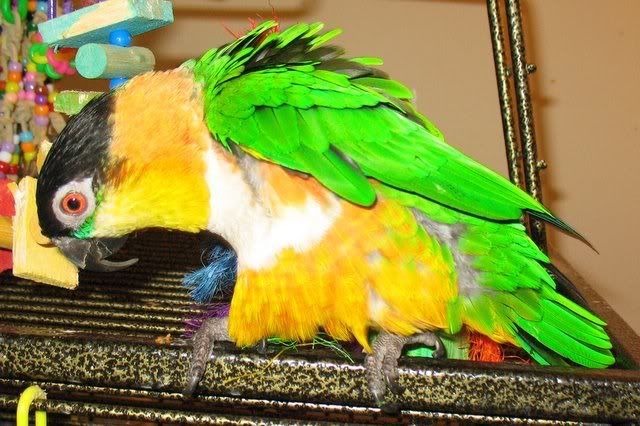Whoever would want to teach their bird to bite? Unintentionally, many people do just that. I've seen quite a few up at the rescue lately, so I thought I'd write a post about it. Obviously this does not cover every kind of bite that a parrot may give, but by paying attention to body language, you can greatly reduce those kinds as well.
Parrots use their beaks for many things -- exploring, eating, showing affection, preening, etc., etc. However, the first thing many people think when they see a beak coming towards them is BITE!!! Even though that's likely one of the furthest things from the parrot's thoughts.
I have seen many people teach their birds to bite in the following manner: they ask the bird to step up. The bird wants to make sure he's stepping onto a stable perch, so he bends down, intending to gently grab the human's finger/hand to make sure it's a safe place to go (especially if the parrot can't fly away if the perch is unsteady). The human, worried about getting bit, quickly pulls her hand away.
The process is repeated, though the parrot starts to be a bit more aggressive in testing the offered hand -- either biting down a bit harder or going a bit quicker in order to get to the hand before it is taken away again. Before you know it, it's become a game. The human has taught their bird to bite.
So, what to do? Watch the parrot's body language closely. Do not assume that just because the parrot is approaching your hand with his beak open means he's planning to bite.
Stella, who almost always puts her beak on my hand before stepping up, was kind enough to agree to model this behavior. Notice how she continues to preen my hand after she's stepped up -- this is a sign of affection from her.
Some birds are beakier than others. For example, Max steps up without putting her beak on me probably 50% of the time. Beeps almost always gently rests the top of his beak against my hand, beak closed. Rocky rarely puts his beak on the stick when I ask him to step up.
As always, the key is closely watching your parrot's body language.
Subscribe to:
Post Comments (Atom)


2 comments:
I can't recall Harley doing this when he steps up on a hand, but boy! Does he ever when he gets up on a stick! A big old bite plus a big screech - every time! I don't remember teaching him that, but obviously I did!
Great post, it is so very true. I also always try to remind people that while it is important to give the bird a chance to step-up, you don't want to force them.
Post a Comment